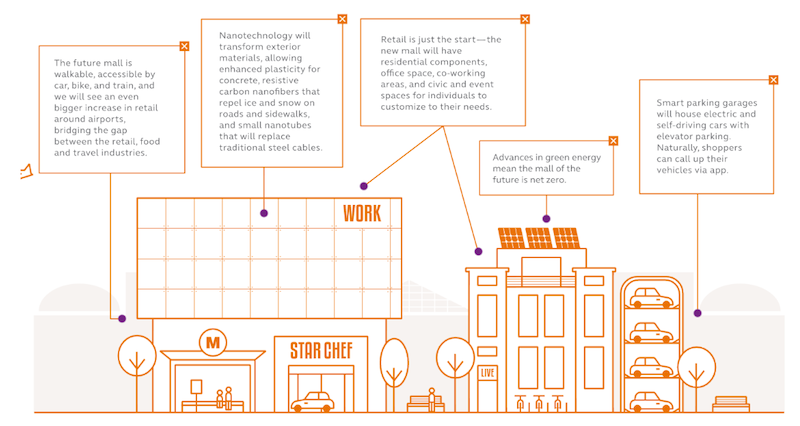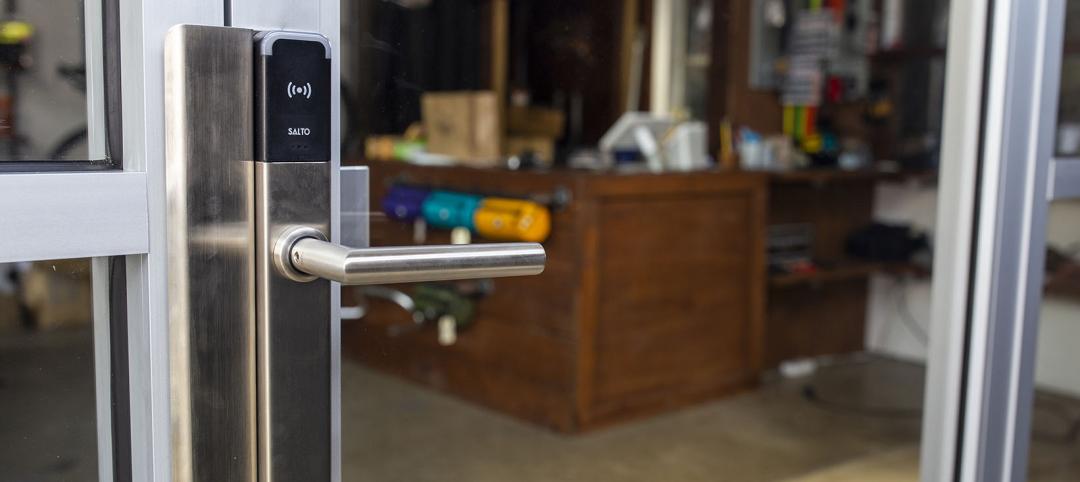The shopping mall of tomorrow will be more like a community center, with access to mass transit, offices, apartments, museums, and services like childcare. Already, some malls have become micro cities that are “changing the face of American retail,” according to CallisonRTKL in its “Mall of the Future,” a compendium of ideas and design trends that the firm believes could drive where shopping malls and retail will be heading over the next two decades.
The firm’s portfolio includes some of the world’s largest and most complex retail malls, so it’s not surprising that CallisonRTKL foresees shopping centers as focal points of urbanized living. Indeed, the firm all but predicts that malls that don’t move in this direction are in danger of becoming extinct at a time when at least one-third of the 1,200 retail malls in the U.S. are on death’s doorstep, and customer expectations about their shopping experiences are rapidly evolving.
'Design wise, malls will require twice the common area of typical malls we see today.'
For one thing, customers want to get out of their cars. CallisonRTKL’s report cites research from the Urban Land Institute, which finds a strong preference among all adult age groups to live in or near mixed-use, walkable neighborhoods.
More broadly, the new generation of shopper is seeking new experiences, not just waiting for them. Retail centers must be flexible in their spaces and assortments to continually offer enough variety that can drive customer traffic. Citing research from Medallia Analysis, CallisonRTKL points out that satisfied customers spend, on average, 140% more than people who are less satisfied with their shopping experiences.
Despite double-digit growth in online shopping in recent years, CallisonRTKL remains bullish on bricks-and-mortar shopping centers.
One of their major competitive responses to online shopping’s encroachment has been food: CallisonRTKL notes that for the first time ever, Americans in 2015 spent more money on dining out than on buying groceries. So malls are adding higher-end restaurants that feature local cuisine. More retail centers are giving customers the option of ordering food online and picking it up at the mall. Some centers have even programmed space for farmers’ markets and community gardens.
Technology is transforming the mall environment. It is unleashing areas used for warehouse space for “click and collect” products and same-day delivery of online sales. More malls are installing interactive maps and wayfinding signage. The Internet of Things is helping retailers market directly and instantaneously to wired shoppers via their smartphones.
 Shopping will just be one facet of tomorrow's successful malls, which will tap into customers' desire to live in walkable, greener communities. Image: CallisonRTKL's “Mall of the Future” report
Shopping will just be one facet of tomorrow's successful malls, which will tap into customers' desire to live in walkable, greener communities. Image: CallisonRTKL's “Mall of the Future” report
CallisonRTKL expects all of these trends to become more widely applied in the malls of tomorrow. The firm foresees walkable malls accessible by public transit or bicycles. Malls will include residential, office, civic, and event spaces. They will be powered by renewable energy. Smart parking garages will accommodate electric cards, and driver apps. The firm also expects more malls to be built near airports, “bridging the gap between retail, food, and travel industries.”
Technology will seep into every aspect of a mall’s design, construction, and operations. “It’s not about gadgets; it’s about infrastructure,” CallisonRTKL wrote. Nanotechnology will help develop better, more durable building products with smaller carbon footprints. Click and collect “will remain and must,” and be much quicker. Broader and better connectivity will provide a customized shopping experience. Stores will include interactive fitting suites that allow customers to digitally try on products before ordering them online. Stores will stock less, and use extra space for warehousing inventory for same-day drone delivery.
Rooftops of malls will be employed for entertainment, dining, and gardens, and be “greener” by reducing heat transmission and water runoff. Customers will use apps to have food and goods delivered anywhere, with alerts for when the pickup is ready and where. Robot delivery will be an option for some malls.
Food will anchor the retail experience, in the forms of restaurants, farms, pop-up vendors, specialty stores, and food festivals. Some of these could be programmed to change daily.
CallisonRTKL goes so far as to suggest that some malls might allow diners the option of growing their own dinners from onsite vegetable gardens and urban beehives. At the very least, successful malls will have pop-up infrastructures that are anchored by preset retail common areas. “Design wise, malls will require twice the common area of typical malls we see today.”
CallisonRTKL foresees more consumers actively seeking shopping experiences that align with their environmentalist inclinations. Streamlined sourcing labels, more dependable vetting processes, and increased connectivity will make it easier for shoppers to choose retailers and products that have a positive effect. “This is a consumer-driven movement that is only going to grow stronger in the next few years.”
Related Stories
Adaptive Reuse | Aug 31, 2023
Small town takes over big box
GBBN associate Claire Shafer, AIA, breaks down the firm's recreational adaptive reuse project for a small Indiana town.
Giants 400 | Aug 22, 2023
Top 115 Architecture Engineering Firms for 2023
Stantec, HDR, Page, HOK, and Arcadis North America top the rankings of the nation's largest architecture engineering (AE) firms for nonresidential building and multifamily housing work, as reported in Building Design+Construction's 2023 Giants 400 Report.
Giants 400 | Aug 22, 2023
2023 Giants 400 Report: Ranking the nation's largest architecture, engineering, and construction firms
A record 552 AEC firms submitted data for BD+C's 2023 Giants 400 Report. The final report includes 137 rankings across 25 building sectors and specialty categories.
Giants 400 | Aug 22, 2023
Top 175 Architecture Firms for 2023
Gensler, HKS, Perkins&Will, Corgan, and Perkins Eastman top the rankings of the nation's largest architecture firms for nonresidential building and multifamily housing work, as reported in Building Design+Construction's 2023 Giants 400 Report.
Shopping Centers | Aug 22, 2023
The mall of the future
There are three critical aspects of mall design that, through evolution, have proven to be instrumental in the staying power of a retail destination: parking, planning, and customer experience. This are crucial to the mall of the future.
Adaptive Reuse | Aug 17, 2023
How to design for adaptive reuse: Don’t reinvent the wheel
Gresham Smith demonstrates the opportunities of adaptive reuse, specifically reusing empty big-box retail and malls, many of which sit unused or underutilized across the country.
Sponsored | | Aug 15, 2023
The Data Benefits of Retail Keyless Entry
SALTO’s wireless access control system provides valuable data analytics for retail establishments
Office Buildings | Aug 10, 2023
Bjarke Ingels Group and Skanska to deliver 1550 on the Green, one of the most sustainable buildings in Texas
In downtown Houston, Skanska USA’s 1550 on the Green, a 28-story, 375,000-sf office tower, aims to be one of Texas’ most sustainable buildings. The $225 million project has deployed various sustainable building materials, such as less carbon-intensive cement, to target 60% reduced embodied carbon.
Market Data | Jul 24, 2023
Leading economists call for 2% increase in building construction spending in 2024
Following a 19.7% surge in spending for commercial, institutional, and industrial buildings in 2023, leading construction industry economists expect spending growth to come back to earth in 2024, according to the July 2023 AIA Consensus Construction Forecast Panel.
Standards | Jun 26, 2023
New Wi-Fi standard boosts indoor navigation, tracking accuracy in buildings
The recently released Wi-Fi standard, IEEE 802.11az enables more refined and accurate indoor location capabilities. As technology manufacturers incorporate the new standard in various devices, it will enable buildings, including malls, arenas, and stadiums, to provide new wayfinding and tracking features.

















